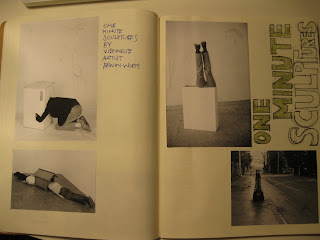Monday, 31 January 2011
IDEAS FOR THE DEVICE
Tuesday, 25 January 2011
CONSTRUCTION IDEAS




Monday, 24 January 2011
DEVICE
Friday, 21 January 2011
HUMAN IN SPACE
HUMAN INSTALLATION





ON SITE ROLLERCOASTER
ROLLERCOASTER RESEARCH
Striving to Build a Better Coaster
With the need to keep thrill seekers satisfied and returning to their favorite parks year after year, theme park owners are always looking for the next great coaster. To appeal to roller coaster lovers, parks strive to build the biggest, longest, highest and fastest coasters.
Longest
The longest steel coaster prize goes to Steel Dragon 2000, at Nagashima Spaland in Mie, Japan. Steel Dragon, which opened in 2000, totals 8,133 feet of track. Daidarasaurus, at Expoland in Suita, Japan (which opened in 1970) has the second longest track, measuring 7,677 feet. In the United States, Beast, at Kings Island in Ohio, measures 7,359.
Fastest
Kingda Ka at Six Flags Great Adventure currently holds the record for fastest speed, reaching 128 miles per hour. The coaster opened in May 2005 in the jungle themed area of Great Adventure. Placing a close second, at 123 miles per hour, is Top Thrill Dragster at Cedar Point, Steepest Angle of Descent
While many modern steel roller coasters boast a 90 degree angle of descent, there are actually four coasters that have a 97 degree angle - Vild-Svinet (in Denmark), Typhoon (Belgium), Speed: No Limits (United Kingdom) and Rage (United Kingdom). In the United States, Mystery Mine at Dollywood and Maverick at Cedar Point both reach angles of 95 degrees. Additionally, two U.S. coasters can take the prize of tallest coasters with a 90 degree descent - Griffon atBusch Gardens Europe in Williamsburg, Virginia (205 feet at 90 degrees) and SheiKra at Busch Gardens Africa in Tampa, Florida (200 feet with a 90 degree drop).
Highest
Kingda Ka, already ranked number one for speed, also takes the top prize for height, reaching 456 feet. Again, Top Thrill Dragster at Cedar Point takes second place for a height of 420 feet.
Biggest Drop
Kingda Ka takes the top spot for the largest drop of any roller coaster, 418 feet from the top of the largest drop to the bottom. Top Thrill Dragster's drop places second, at 400 feet.
Geographic Facts
For roller coaster enthusiasts, finding out where the most roller coasters are located ensures that riders get the most bang for their buck during their theme park visit. Cedar Point is a coaster lover's paradise, with an impressive 17 roller coasters to choose from. Six Flags Magic Mountain comes in a close second with 15 roller coasters. opened in May 2003.Early History
Of course, it's not all about the thrills. Some park visitors marvel at the history of roller coasters, from their humble beginnings as moderate amusements to the heart-racing adventure rides of today. The following are just a few of the roller coaster facts that make the history of this ride so interesting:
- The concept for roller coasters was first conceived in 15th century Russia, where they constructed ice slides between seventy and eighty feet tall and hundreds of feet long that people rode on sleds.
- Two coasters were built in France in the early 1800s that first featured wheeled cars that locked to the track for riders to sit in.
- The first American roller coaster was actually a train for moving coal down a mountain, called the Mauch Chunk Switchback Railroad. After the train no longer needed to transport coal, passengers began to ride this thrilling train from the 1850s through 1929.
- La Marcus Adna Thompson is credited with conceiving and patenting the first roller coaster in America in 1878. He created the Switchback Railroad at Coney Island, which opened in 1884.
- The oldest operating roller coaster is Leap the Dips at Lakemont Park in Pennsylvania, built in 1902.





























